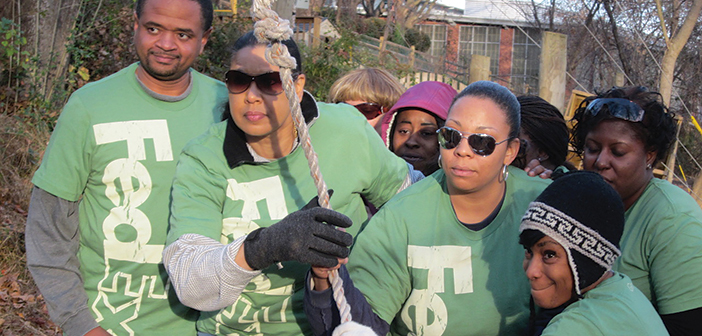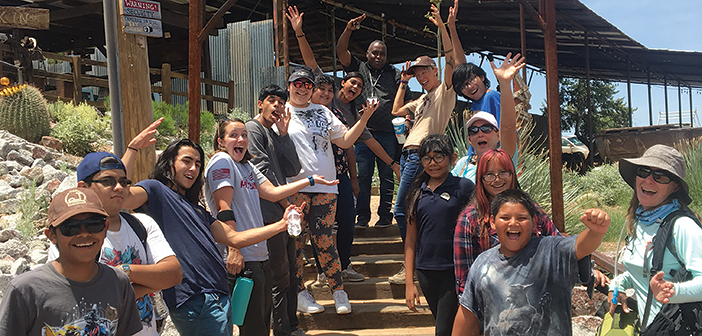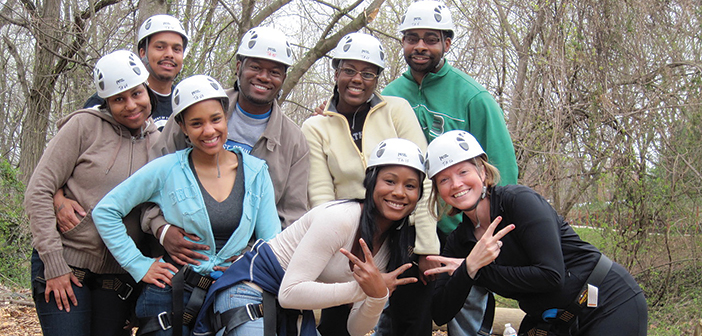It’s no secret that the traditional landscape and portrayed image of the outdoor world is homogeneous, historically white, and male. Yet, more and more outdoor industry leaders, activists, and brands seek to forge authentic connections with people across all backgrounds. Aerial parks and tours have been ahead of the curve in many ways, and can play a key role in the arc of the overall outdoor business.
In the last few months alone, we have seen essays addressing diversity from Teresa Baker, founder of the African American Nature and Parks Experience, and from Canada’s Mountain Equipment Co-op (MEC) CEO David Labistour. With good reason: The U.S. Census Bureau estimates that by 2044, minorities—any race that is not single-race white—will be the majority. As Outside Magazine reports, diversity and inclusion need to be a business priority for the outdoor industry in general.
As more people explore the outdoors and engage in adventure travel, aerial adventure parks play an increasingly important role in the expansion of diversity and inclusivity. The experience of two parks, Terrapin Adventures in Savage, Md., and Arizona Zipline Adventures in Oracle, Ariz., illustrates this well.
Aerial parks sit at a unique intersection of a cultural diaspora: Zip lines and aerial courses enable virtually anyone, regardless of technical skill or experience level, to participate. And they are often located in or near metropolitan areas or vacation destinations. That has allowed parks to address diverse populations across religions and cultures, able-bodied-ness, sensory impairment, languages, ethnicities, and urban populations.
Teaching Urban Youth
Not surprisingly, the proliferation of zip tours and aerial adventure parks across the continent has led to broader customer engagement among locals and travelers. Thoughtful preparations regarding backgrounds and beliefs, as well as tactful marketing, are key components to helping all guests feel invited and comfortable.
Terrapin Adventures greatly focuses this effort on youth. The park hosts an average of 30 urban school groups annually from Baltimore and Washington, D.C., for single and multi-day adventures.

Terrapin Adventures’ marketing initiatives include images and videos highlighting people of color to extend an inclusive welcome to a multicultural audience.
The group sizes range from 30 to 125 students, and ages 12 to 17. In total, 60 percent of the site’s annual volume is comprised of the school groups, estimates Matt Baker, chief adventure officer of Terrapin Adventures. About 95 percent of the groups come for a day visit, while a handful of select groups—such as Boy Scouts of America and Terrapin Adventure summer camp attendees—stay overnight, nearby, for a multi-day adventure.
Due to a range of cultural, social, and economic backgrounds, many of these kids have no prior experience with exploring and playing in the woods, so they require extra time and education from the guides.
“A lot of inner-city kids aren’t used to being in the woods, so they get sensitive to cold, rain, heat, and the overall conditions,” says Baker. Most of the attending youth from inner-city schools are African American, although a significant portion—15 percent—is Hispanic, according to Baker. Guides are briefed prior to any group visits, so that they can prepare for the goals, age, and needs of the individuals.
If the temperatures spike—like last summer’s 98-degree days with 90 percent humidity—then the kids will hydrate more and take frequent breaks to go indoors, where they can play team-building games in the comfort of air-conditioned rooms. Terrapin sends group liaisons an advance reminder of what the participants should wear, so that the kids are comfortable all day.
“Most of the kids do enjoy the forest, though some are concerned about bugs. We explain what they are seeing out there, along with using the ‘challenge by choice’ doctrine,” says Baker. That principle allows participants to opt into or out of various activities and to be supported by the group.
“We have a lot of repeat business—a new 8th grade class every year, for example, and many repeat youth groups. We also work with student tour groups,” explains Baker. Overall, half of Terrapin’s annual business is repeat. New customers are attained via referrals, an SEO campaign, and digital marketing that targets teachers, administrators, Girl and Boy Scout troops, religious youth groups, local camps, and student tour operators.
Offering Aid: Sensory-Impaired Visitors
To help guide guests who are hearing impaired, Baker provides a script to explain the obstacles. “We are an oral type of service, so I need to provide an explanation in writing before each obstacle with the steps and cautionary pointers,” he says.
Certain obstacles that draw guests far away from their guides, like the climbing tower, can present a huge dilemma: It can be difficult for an instructor to communicate with hearing-impaired climbers from the ground.
“In the past, I had to get one group’s attention by shaking the rope [attached to their harness], so that they knew someone was trying to communicate with them from down below,” says Baker.
Conversely, for visually impaired visitors, the verbal communication is dialed up and very detail-oriented. For example, guides list the number of rungs on a ladder, and describe the number of steps adjacent to a wall that lines a walkway.

Terrapin Adcentures’ images and videos also feature adult and business groups that display diversity.
And there’s good reason to make these accommodations: Aerial parks can be a confidence-building experience for sensory impaired participants. Three years ago, Arizona Zipline Adventures—35 miles north of Tucson—launched an annual summer program for visually impaired youth to experience the zip line tour. Close to 25 campers attend, ranging from 14 to 20 years old.
To develop a safe program, AZA employs additional staff who can help the campers walk between obstacles. These staff require comprehensive training.
“We make sure our staff knows the proper terminology and how to best instruct visually impaired campers with walking directions,” says director of operations Emily Goff. Other communication methods are adjusted, too. For example: “In order for visually impaired users to know when to brake, we change our system: We use air horns rather than hand signals,” Goff notes.
Helping Disabled Participants
Terrapin Adventures also serves guests with inhibited use of their limbs.
“A person with limited use of their legs will need a certain amount of upper body strength so that they can complete the course, and we do need to set up a hoisting mechanism to get them up to the top of the zip line, which requires extra time,” explains Baker. A person with limited use of his or her legs might need 20 minutes to complete the zip line compared to the three-minute average.
Many autistic children likewise frequent Terrapin Adventures. Additional chaperones are usually required to create a ratio of one adult to one or two children, depending on the individual’s needs.
“Autistic children can have attention deficit disorder or over-stimulation, so we need to utilize the help of chaperones, so that we can focus on guiding the group,” says Baker.
Welcoming Religious Groups
One of the most common examples of diversity that aerial parks encounter are religious groups.
“We welcome guests from different religious faiths and try to accommodate their unique requests,” says Baker. For example, Terrapin makes adjustments for Islamic groups that request same-sex guides, and Orthodox Jewish visitors who wear long dresses, which don’t seamlessly pair with a harness.
Typically, these guests arrive with leggings underneath their dresses, and some choose to layer the dress underneath the harness, versus draping over the top of the harness.
“We need to make sure that when we put the harness on, we still have access to the belay loop, and we need to be able to tighten up the harness appropriately,” says Baker.

Arizona Zipline Adventures prepares for groups by addressing any physical or language barriers ahead of time. Advance communication helps make the process smooth and enjoyable for everyone.
One of the attractions at Terrapin Adventures is a climbing tower. Skirt-wearing participants might face a slightly greater risk of tripping as they ascend; however, they can always opt out of the climb if they are uncomfortable, explains Baker.
Arizona Zipline Adventures has managed similar nuances with customers. Last summer, a religious all-girls youth group visited Tucson from New York, and the aerial park was on their itinerary.
“The girls were all Jewish and wore skirts, so we included extra time for their reservation. When they arrived, we needed to make sure that they were all wearing leggings under their skirts, so that they could put on harnesses accordingly while also abiding by their religious requirements,” says Goff. She adds that the skirts weren’t long enough to warrant a risk of being snagged on equipment or the surrounding environment.
Employee training is a key component for managing customer relations with clarity, sensitivity, and openness. “As far as training goes, we have our guides ask permission before they can put their hands on a person, which is especially important with these groups that have specific belief systems and preferences,” says Baker.
Bridging the Gap: Language Barriers
Beyond communication needs, aerial parks are a crossroad for languages. The majority of visitors at AZA arrive from Tucson, Phoenix, New Mexico, and Mexico, and a good number of these folks speak Spanish.
“One thing that we experience quite a bit is different languages, and we try to be as prepared as possible. We have a really diverse, incredible staff who can speak Spanish or sign language fluently, which also helps us with communication with those who are hearing impaired,” says Goff.
Visitors at Terrapin Adventures also span a spectrum of languages. The company provides its waiver in English and Spanish, and employs staff who can speak sign language and Spanish, though employment varies season to season, which presents a challenge.
Marketing to Diverse Populations
Proactive businesses generally employ two tactics to support and engage the wide spectrum of customers. First: intentional, authentic marketing. And second: employee training that prepares staff to address the specific needs of customers.
In common practice, Terrapin Adventures and Arizona Zipline Adventures feature their day-to-day visitors in marketing content—both video and photographs—that the parks use on social media and their business websites. They both capitalize on authentic visitors by planning ahead to capture moments with groups that represent diversity across age, race, and ethnicity.

While Terrapin Adventures has focused on school groups, it has also highlighted teambuilding and bonding for adult groups as well.
“We are always conscious and try to show a diverse population using our course, so that people can see it’s not just a certain population using the course and that the course is for all types of guests,” says Baker. For the autumn 2018 season, Terrapin Adventures completed new videos for its website: “We focused on adult groups to show serious team building, youth groups, and people of color. And we made sure we were able to shoot all the different course elements,” Baker notes.
Communication and Flexibility are Key
If guests require extra time on obstacles, the course can become bottlenecked. To mitigate traffic jams, Terrapin’s website encourages guests with particular needs or little experience in the outdoors to reach out in advance of their visit. With a proper heads-up, Baker can make adjustments to the schedule based on particular needs. All types of scenarios are manageable sans interrupting day-to-day operations.
Employees also need training on how to conduct honest, straightforward conversations with customers. Managers, guides, or guest-relations staff should be comfortable asking: “What limitations do you have, physically or otherwise?” With sound communication to open the door, guests feel more comfortable and are more likely to explicitly share those needs.
Clear communication isn’t solely about providing clear verbal messages. Multimedia is useful, too. For example, videos that feature the obstacles on the park website are an important tool to aid customers, especially if a guest does not speak English, or for those who are deciding how compatible their needs are with the obstacles.
Goff emphasizes the importance of on-the-spot adaptability. “The main thing I recommend is for operation managers and staff to stay open and stay flexible, so that they can better accommodate specific groups. That flexibility is what will give them the feedback and customer value that is irreplaceable,” she says.
Overall, fostering direct, open dialogue between outdoor businesses and people of all backgrounds helps to usher a diverse, inclusive, and equity-driven culture—which inspires everyone to live well and expands the potential market.
“Over the years, I’ve been surprised by what people with physical challenges can do, and watching them complete this course—like one woman with one arm, who did the high ropes course. It was hard, but she did it,” says Baker.
To realize our greatest potential, both operators and participants need a willingness to evolve.



